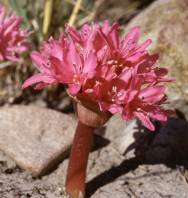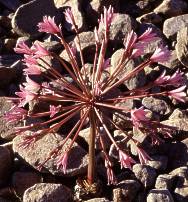Brunsvigia
Brunsvigia Heist.
Family: Amaryllidaceae
Common names: candelabra flower (Eng.); kandelaarblom, Maartblom (Afr.)
Introduction
The sheer exuberance of brunsvigias flowering en masse is a natural spectacle that should not be missed.

Description
Description
Brunsvigias are deciduous, temperate, bulbous plants. Most species have subterranean bulbs but they are usually half-exposed in B. herrei and B. josephinae. The bulb tunics are typically brittle and tan-coloured, although they are brown and papery in B. josephinae and B. litoralis.
When mature, the leaves are broad and oblong to tongue-shaped. In species with small bulbs - B. radula , B comptonii and B. namaquana -there are just two or three leaves per plant but most other species have at least four leaves per bulb. B. josephinae has the distinction of producing as many as 20 leaves. The leaves mostly lie flat on the ground and sometimes press down so firmly that they lie vertically if the bulb is dug up. Only in B. litoralis , B. josephinae , B. grandiflora, B. undulata and B. herrei do the leaves stand clear of the ground. Although usually smooth, the upper leaf surfaces of two Namaqualand species ( B. radula and B. namaquana ) are covered with straw-coloured bristles and in some populations of B. striata from the southern Cape, they bear soft, scale-like hairs. In the winter rainfall region of southern Africa, the foliage is produced after the flowering heads have been shed, whereas in the summer rainfall region the vegetative and flowering stages often overlap.
The inflorescences are extremely eye-catching. In most species the pedicels are straight and radiate outwards to form an almost perfectly spherical head. However, B. litoralis , B. josephinae and B. orientalis differ in having pedicels that curve below each flower. Just three species ( B. pulchra, B. marginata and B. elandsmontana ) have compact, brush-like inflorescences. The flowers vary from ruby-red to brilliant scarlet or pale to bright pink and in some species the entire inflorescence is attractively coloured. When in flower, the plants are spectacular but the flowering period is brief and restricted to summer and autumn. Pink flowers are the norm, whereas red flowers are found in B . marginata , B. orientalis, B.litoralis and B. josephinae. Floral markings are often variable within species but dark veins on the tepals are characteristic for B. bosmaniae and B. gregaria.
The six tepals of each flower are free to the base or shortly fused into a tube. Radially symmetrical, trumpet-shaped flowers occur in species with compact, dense inflorescences, whereas bilaterally symmetrical flowers occur in species with open, lax heads. In B. comptonii , B. radula and B . namaquana, the flowers are highly asymmetrical as all but one tepal curve upwards. Often the flowers are scented and all produce nectar.
The water-rich, non-dormant seeds are borne in dry capsules that are spindle-shaped or three-angled and often heavily ribbed.
Conservation Status
Status
Today only B. litoralis is endangered due to housing developments overtaking its coastal habitat between Cape St Francis and Port Elizabeth.
Distribution and habitat
Distribution description
Brunsvigia has about 20 species in total and is widespread in southern Africa, mostly in the semi-arid areas. More than half the species are found in the winter rainfall region but several species are also found along the Drakensberg, KwaZulu-Natal, in the summer rainfall region.
Species range from the coast to the inland escarpment. Some favour specific substrates like quartzite veins, dolomite outcrops, shale bands and sandy plains. Only a few occupy seasonally damp depressions, mainly in the eastern summer rainfall region. Most species are widespread but a small number (B . elandsmontana, B. herrei, B. namaquana, B. pulchra, B. radula, B. striata and B. undulata ) are naturally rare.
Derivation of name and historical aspects
History
The name Brunsvigia was first published in 1755 by Lorenz Heister (1683-1758), a botanist and professor of medicine at the University of Helmstädt. It honours Karl, the Sovereign of Braunschweig, who promoted the study of plants, including the beautiful Cape species B. orientalis.
Ecology
Ecology
The flowering heads function highly effectively to attract pollinators and to disperse seeds. The pollination ecology of the genus as a whole is poorly understood, despite what is known about the diverse pollination strategies of the winter rainfall species. At dusk noctuid moths pollinate the trumpet-shaped, pink flowers of B. bosmaniae . During the day the big, brown butterfly, Aeropetes tulbaghia , which is commonly known as the Pride of Table Mountain, visits the brilliant red flower clusters of B. marginata . Other day visitors are sunbirds that feed on the nectar of the red, somewhat tubular flowers of B. josephinae, B. litoralis and B. orientalis . Anyone who has seen the ease with which malachite and Lesser double-collared sunbirds perch on the pedicels and probe the flowers will appreciate how perfectly these species are suited to bird pollination.
Once dry, the light, spherical, fruiting heads break loose from the bulb. The triangular-shaped capsules of many species are reminiscent of small kites, which enable the heads to tumble across the ground in the wind. In so doing, the capsules break open and scatter their seeds. [See picture in Amaryllidaceae]
Uses
Use
In southern Africa, the bulbs of Brunsvigia are traditionally used as decoctions to enhance the accuracy of the dice thrown by local diviners. Otherwise infusions of the bulbs are used for medicinal purposes. Like all Amaryllidaceae, however, brunsvigias are rich in alkaloids that can be extremely toxic.
The species listed occupy remote or often inaccessible places and may not be easily seen. Nevertheless, they are spectacularly lovely or fascinating and worthy of attention.
Growing Brunsvigia
Grow
Brunsvigia, unlike its close relative Nerine, is poorly suited to commercial horticulture and garden plantings. The group mostly finds favour with the specialist bulb grower. Watering of the plants needs to be strictly controlled, so they are best treated as pot subjects, usually in large containers to accommodate their long, perennial roots. They require well-drained soil and full sun. Although hardy in southern Africa, they require a cool greenhouse in the Northern Hemisphere.
Species

B. elandsmontana Snijman: plants up to 200 mm high; bulb 40 mm diam. Leaves dry at flowering, 4-6, pressed to the ground, elliptical, 25-70 mm wide; margins pink, crisped. Flowers 6-18, in a compact head; tepals 15-20 mm long; stamens and style nearly straight, almost equalling the tepals. Capsule 10-25 mm long, 3-angled, thinly ribbed. Flowering March to May. In lowland fynbos and renosterveld, in pebbly soils. (W Cape: Elandsberg Private Nature Reserve).

B. herrei F.M.Leight. ex W.F.Barker: plants up to 450 mm high; bulb 100 mm diam. Leaves dry at flowering, 6, suberect to spreading, strap-shaped, 20-90 mm across, greyish green, tough; margins red. Flowers up to 40, in an open spherical head; tepals 40-55 mm long; stamens shorter than tepals. Capsules 45-50 mm long, sharply 3-angled, heavily ribbed. Flowering March. High-lying plateaux, in gravely or rocky places. (S Namibia to N Namaqualand).
B. marginata (Jacq.) Aiton: plants up to 200 mm high; bulb ± 60 mm diam. Leaves dry at flowering, 4, pressed to the ground, elliptical, 40-100 mm wide, leathery. Flowers 10-20, in a compact, hemispherical head, red or rarely dark pink; pedicels elongating in fruit; tepals 20-30 mm long; stamens well exserted. Capsule 20-25 mm long, 3-angled, thinly ribbed. Flowering March to June. Mountain slopes, in rocky shale bands. (W Cape: Citrusdal, Tulbagh, Paarl, Worcester).
B. radula (Jacq.) Aiton: small plants, up to 100 mm tall; bulb 30 mm diam. Leaves dry at flowering, 2, pressed firmly down, elliptic, 20-40 mm across; upper surface densely covered with straw-coloured bristles. Flowers 8-15, in a small open head; tepals 12-25 mm long, mostly curved into the upper half; stamens about as long as the tepals. Capsule egg-shaped, 10 mm wide, soft-textured. Flowering February to April. In crevices of dolomite outcrops. (Namaqualand, Knersvlakte).
References
- Du Plessis, N. & Duncan, G. 1989. Bulbous plants of southern Africa . Tafelberg, Cape Town.
- Dyer, R.A. 1950. A review of the genus Brunsvigia . Plant Life 6: 63-83.
- Dyer, R.A. 1951. A review of the genus Brunsvigia Heist. Plant Life 7: 45-64.
- Leistner, O.A. (ed.). 2000. Seed plants of southern Africa: families and genera. Strelitzia 10. National Botanical Institute, Pretoria.
- Manning, J., Goldblatt, P. & Snijman, D. 2002. The color encyclopedia of Cape bulbs . Timber Press, Portland, Cambridge.
- Smith, C.A. 1966. Common names of South African plants. Memoirs of the Botanical Survey of South Africa No. 35. Department of Agricultural Ttechnical Services, Pretoria.
- Watt, J.M. & Breyer-Brandwijk, M.G. 1962. The medicinal and poisonous plants of southern Africa and eastern Africa . Livingstone, Edinburgh & London.
Credits
Author
Dee Snijman, Compton Herbarium, Kirstenbosch
Images
Colin Paterson-Jones, Fernwood, Cape Town
April 2005
Plant Attributes:
Plant Type:
SA Distribution:
Soil type:
Flowering season:
PH:
Flower colour:
Aspect:
Gardening skill:
Special Features:
Horticultural zones






Rate this article
Article well written and informative
Rate this plant
Is this an interesting plant?
Login to add your Comment
Back to topNot registered yet? Click here to register.